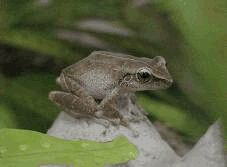E-Mail to HDOA Return to
Hawaii's |
The Hawaii Department of Agriculture is participating in a multi-agency campaign to stop the spread of coqui in Hawaii. This webpage provides information on the coqui problem and also asks the assistance of the public's eyes and ears to report possible new infestations of coqui. This page will also provide links to other sources of information on coqui. What is a coqui? The coqui is a small light-brown to dark-colored frog with variable patterns including a light stripe down the middle of its back. Adult frogs measure up to two inches. What does it sound like? The mating call of the male coqui is similar to a two-note bird-like chirp or whistle, which starts at dusk and may continue throughout the night. Females do not vocalize. To download and listen to the mating call, click HERE. Where did it come from? The coqui is native to Puerto Rico. It is also found in the southeastern part of the United States. Why is it a problem here?
How did they come here? It is widely assumed that the frogs arrived in potted plant material from the mainland or Puerto Rico. How are they spread?
What do I do if I think I hear a coqui? If you hear a bird-like call or whistle during evening hours, you can look for the coqui by using a flashlight to locate the frog, capture it by hand (the coqui is non-toxic) or use a jar with a lid to contain the animal. Do not transport the coqui from the area.
CALL the State's Toll-Free PEST HOTLINE at: What happens if someone is caught with coqui? Any person or organization who intentionally transports, harbors or imports with the intent to propagate, sell, or release the coqui is in violation of State law and may be charged with a class C felony and subject to a minimum fine of $50,000 and maximum fine of $200,000, plus 3 years in prison. How can I get posters and information cards on coqui? Contact the Hawaii Department of Agriculture Public Information Office at 973-9560 or to e-mail, click here. To download an 8" x 11-1/2" informational poster on the coqui, click HERE. Other items on the coqui web:
|
||
